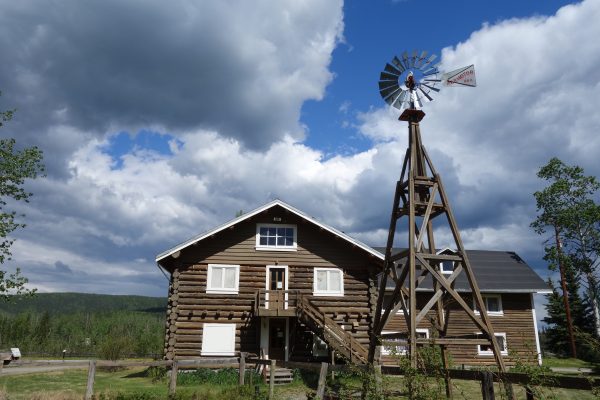Roadhouse provides a rest along the trail
June 8, 2017
Ned Rozell
907-474-7468

RIKA'S ROADHOUSE — Sitting in the shade of a poplar, I watch the Tanana River flow by. It's flat and tan, dimpled by eddies and darted over by swallows that sound like they are chewing rubber bands.
I slept last night with my wife, daughter and dog in the upstairs of a handsome, two-story log structure that has stood since before World War I. Tonight, my dog Cora and I will sleep there again.
Judy Hicks, who lives here in Delta Junction and works for Alaska State Parks, invited us to stay at Rika's Roadhouse. She heard about my walk along the path of the trans-Alaska pipeline and thought it natural for someone who arrived on foot from Valdez to catch a bit of rest here. It happened so many times in the past.
We are happy for the break. During a snowy, rainy, windy trip through the Alaska Range (much of it with my wife Kristen and daughter Anna), we seemed to be walking back in time. As we gained elevation, leaves turned back to buds and temperatures not felt since April reappeared.
With our recent hike past Donnelly Dome and into green flats came dry, hot weather. To Cora and me, 68 and sunny felt like a summer day in Badwater. And, because we descended from mountain hills to the drained gravel and sand left behind by glaciers, there was not a puddle to be found.
If it wasn't for a security guard named Travis at Pump Station 9, we would have gone a day without water. He gifted us as many bottles as we wanted. Cora drank a quart right there at the entrance to the pump station.
After a similar day yesterday of hiking crunchy dry ground from Jarvis Creek to here, it was nice to have refuge. Kristen and Anna came from Fairbanks to spend a night and resupply me with food and a packraft for the crossing of the Salcha River in a few days.
The grounds here remind me of the town of Eagle: a split-rail wooden fence on the edge of a lawn overlooking the river, breeze through the new leaves, minty scent of balsam in the air, songs of yellow warblers and white-crowned sparrows.
Alaska State Parks operates the Big Delta State Historical Park. State budget cuts may cost Judy Hicks her job in July. Then, management of the site probably switches to "passive," meaning there is no money for employees. The roadhouse, now a museum, will be locked.
Too bad. This place has been a waypoint for travelers for a long time. Lt. Henry Allen found Native structures here during his epic trip in the late 1800s. The huts were part of fish camps used by Athabaskans to catch chum salmon as they returned in fall. The Native Alaskans then spent all winter here with their new food supply.
Because this spot lines up with the low pass through the Alaska Range and places north of here, people have been walking it for thousands of years. Rich archeological sites dating back more than 11,000 years dot some hilltops nearby.

This landing on the Tanana near where it meets the Delta River became the site of a roadhouse in 1904. John Hajdukovich, a Yugoslavian who has a splendid mountain east of here named for him, built a new roadhouse. It became a stop for travelers along the route from Valdez to Fairbanks.
Exactly one century ago, Hajdukovich hired Swede Rika Wallen to manage the roadhouse and use her creativity to improve the property. She raised cattle and grew vegetables and fruits. When visitors rolled in, they drank fresh milk and had a breakfast of eggs laid the day before.
Rika Wallen bought the roadhouse from Hajdukovich in 1923 for "$10 and other considerations." She ran it until World War II. She died in 1969 at the age of 94. She is buried on a small hill a pleasant five-minute walk from here. A white fence surrounds her grave.
One year before Rika died, exploratory geologists discovered oil at Prudhoe Bay. Less than 10 years later, workers routed the trans-Alaska pipeline within a few hundred yards of Rika's Roadhouse.
Rising above Cora, who is snoozing on the lawn, is that silvery pipeline, suspended across the big river and pointing our way into Alaska's Interior.
Since the late 1970s, the University of Alaska Fairbanks' Geophysical Institute has provided this column free in cooperation with the UAF research community. Ned Rozell is a science writer for the Geophysical Institute. This summer, he is hiking the path of the trans-Alaska pipeline from Valdez to Prudhoe Bay. He also did the trip 20 years ago.


